This was published 4 years ago
Train travel in Europe: 10 of the best slow train journeys
By Will Hawkes
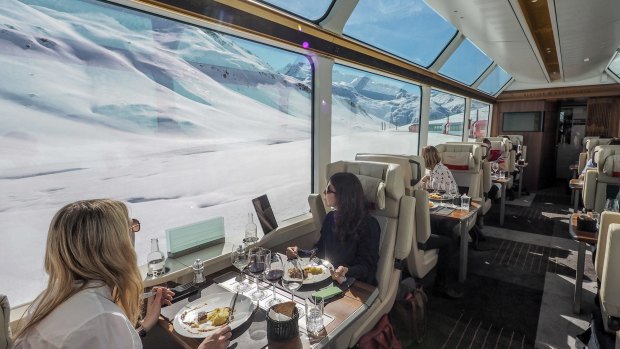
The Glacier Express is billed as the "slowest express train in the world". It runs between St. Moritz and Zermatt in Switzerland.
The day before our holiday in France, I asked my three children what they were most looking forward to. Was it the swimming, the sunshine, the beach or - and I would have put my house on this - eating ice cream every day? "The sleeper train," said the oldest. His brother quickly concurred. And the 3-year-old? Also the train.
In this, they're model Europeans. According to European Union statistics, rail use grew for the sixth consecutive year in 2018, the most recent year for which figures are available. The Eurostar, which links London to Paris, Brussels and Amsterdam, recorded a 7 per cent year-on-year rise in passenger numbers in 2018. Trains are popular in Europe, and increasingly so.
Growing public awareness of air travel's environmental cost is clearly a factor, but more important is the extent of Europe's rail network. The continent is a complex tangle of train tracks. Among the very best services, in my view, are those that are genuinely slow. Trundling across Europe at a snail's pace offers many simple pleasures: the landscape gradually opening up in front of you, a warm summer breeze blowing through an open window, and clocking each sleepy provincial station as they come and go.
I haven't been on all of Europe's rail lines, but I've experienced enough to know what a pleasure it can be. Here are 10 of my favourite slow-train journeys through Europe (prices in Australian dollars).
Bilbao to San Sebastian, Spain
When you go online to book transport between Bilbao and San Sebastian, two of the Spanish Basque Country's major cities, you will be directed toward a coach that takes just over an hour. It's tempting - more time in San Sebastian means more pintxos, Spain's tastiest tapas - but you should resist. Rail (about $11 each way) takes the best part of three hours, but it's time well spent.
The service - a simple commuter shuttle - dives southward out of Bilbao into the lush, deep-green mountains of the Basque Country, before turning north to run along the coast toward San Sebastian. The highlight comes after Deba, where the train hugs the coast for a few miles. On one side, deep blue; on the other, steep descending Basque hills.
Ceske Budejovice to Cesky Krumlov, Czech Republic
The Czech Republic has a comprehensive and cheap rail network. From Prague, you can reach much of the country, but you'll have to change if you want to take one of its most charming journeys (about $2.60 one way; the journey takes 45 minutes). Ceske Budejovice is the home of Czechvar (the Czechs call it Budweiser, though it's different from Budweiser in the United States), one of the country's most famous beers, while Cesky Krumlov is among its most beautiful towns. The gently rolling south Bohemian landscape, with its low-slung farmsteads and forests, is equally beguiling.
Copenhagen to Malmo, Sweden
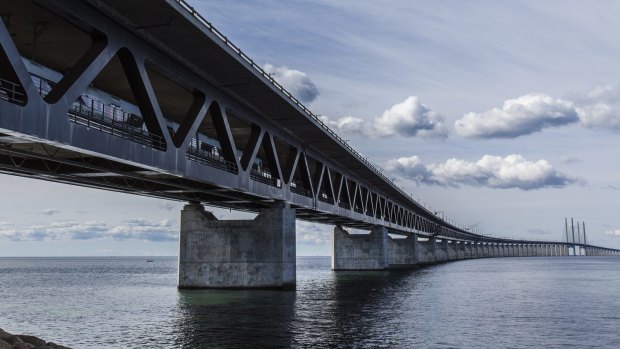
Credit: iStock
There's something thrilling about a bridge that not only crosses a huge expanse of water but also connects two nations. Copenhagen, the Danish capital, has been linked to Malmo in Sweden by the Oresund Bridge since 2000. (The 40-minute journey costs about $19.)
The train descends into a tunnel after Copenhagen Airport station, emerging on Peberholm island, where the five-mile bridge begins. You can see Malmo in the distance, particularly the 623-foot-tall Turning Torso, Scandinavia's biggest skyscraper. In summer, sailboats skip and race across the water; in the colder months, there are miles of foam-flecked gray-blue ocean to admire.
The Glacier Express, Switzerland
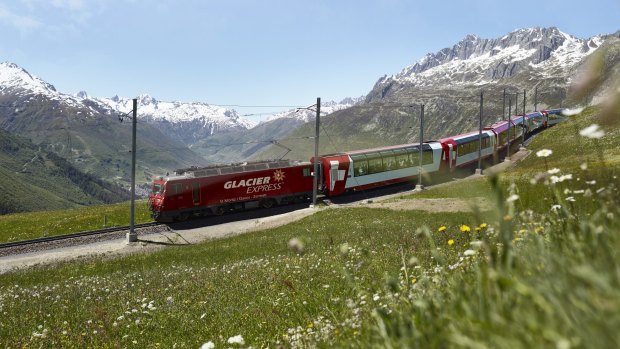
Most of the trips on this list are ordinary passenger services, but the Glacier Express is a tourist train. Sometimes billed as the "slowest express train in the world," it runs between St. Moritz and Zermatt in Switzerland. It's not cheap (prices start about $232, one-way, plus a seat reservation fee; journey time 7½ hours), but the travelling conditions are superb: huge windows, plenty of space and good food.
Watch out for the six-arch, 213-foot-high Landwasser Viaduct, which curves across the Landwasser river; the ascent from Chur up the Rhine Valley to the highest point, at 6,673 feet above sea level; and the steep rock walls of the Matter Valley, before you arrive in Zermatt.
Lille, France, to Roeselare, Belgium
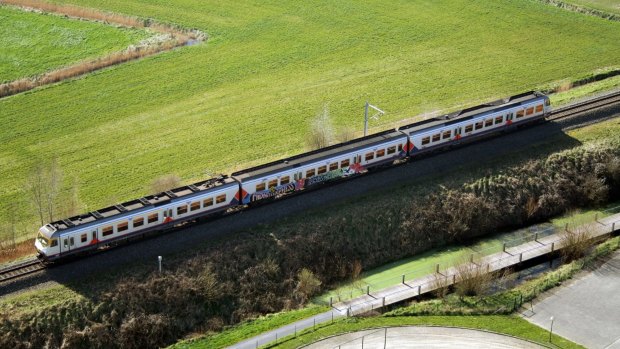
Credit: iStock
One of the beauties of Europe is that sometimes you're not quite sure which country you're in. Travelling from Lille, the capital of French Flanders, into Belgian Flanders can be like that, particularly if you take the wrong train, as I and a group of friends did a few years back (Lille to Roeselare, about $20 one way; change at Courtrai).
We found ourselves on the desolate concrete platform at Froyennes, in French-speaking Wallonia rather than Flemish-speaking Flanders. No matter: There was a connecting train heading north, toward Roeselare, arriving on the other platform. A one-hour journey took two, but no one cared.
Marktredwitz to Regensburg, Germany
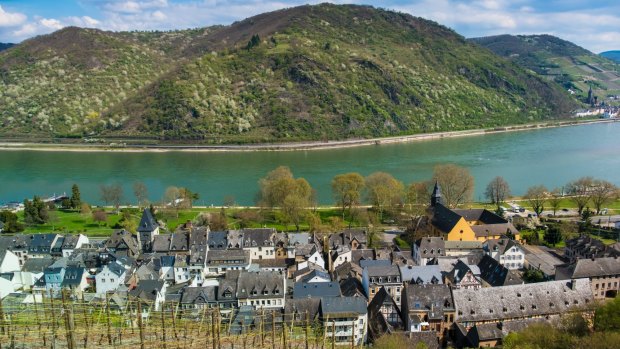
Credit: iStock
The Upper Palatinate, Bavaria's northeastern corner, is perhaps Germany's sleepiest region. It's served by hourly trains that run from Marktredwitz in the north down to Regensburg. (A Bayern Ticket, which allows 24 hours of unlimited travel on all except high-speed trains in the state of Bavaria, costs about $40.)
The trains themselves are sparklingly modern, but everything else has a timeless charm: the decrepit stations at Marktredwitz and Windischeschenbach, the soft, heavily wooded countryside, and the fact that the line hugs the gently flowing river Naab for much of the 1½-hour journey.
Paris to Portbou, Spain
This Intercités de Nuit sleeper service starts with a typically unruly French line at Paris's Gare d'Austerlitz, but that's soon forgotten. The bunks are not plush, but they're comfortable, and prices are low (singles from about $57, with an additional fee if you want the compartment to yourself).
The train pulls out of Paris at just after 10 p.m. and the first stop, announced over the loudspeaker, is Toulouse at 6 a.m. From there, the train heads down the Mediterranean coast, skirting the Etang de Leucate, a huge and placid lagoon, and ends in the cavernous terminus in the border town of Portbou, a relic of a time when this was the main route from France to Spain.
The Rhondda Line, Wales
There's cause to pity regular travellers on the Rhondda Line between the Rhondda Valley town of Treherbert and the Welsh capital, Cardiff: The Pacer trains that serve this route are outdated, cramped and noisy.
But then, they have the Rhondda Valley to enjoy. Earlier this year, I took a late-morning train from Cardiff to Treorchy, one stop short of Treherbert (about $16 round trip; trains every half-hour; journey time just over an hour). Brooding gray summer clouds hung over hills decorated in a hundred shades of green; at Treorchy, where the line is single-track, grass was sprouting long and green between the sleepers. (Additional pleasure: The Rhondda Valley accent, soft and mellifluous, is Britain's loveliest.)
Tren de Sóller, Mallorca, Spain
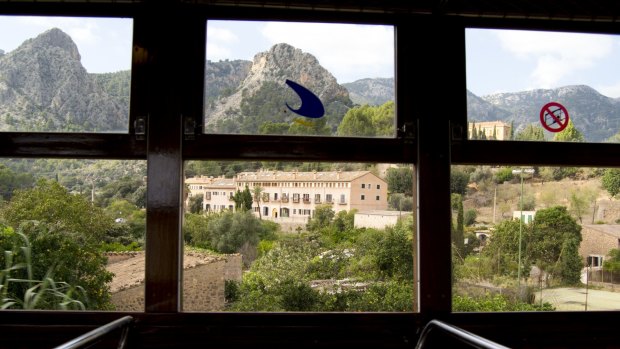
Credit: Getty Images
To take the train from Palma de Mallorca to Sóller, on the north coast of this Mediterranean island, is to travel into the past. The wood-upholstered electric trains, built in the 1920s, glide through the backstreets of Palma and then past orange and lemon groves before climbing - via tunnels, bridges and switchbacks - up and down the Sierra de Alfabia mountain range en route to Sóller, a beautiful seaside town on Mallorca's north coast (about $40 round-trip; tickets must be bought on the day, cash only).
West Highland Line, Scotland
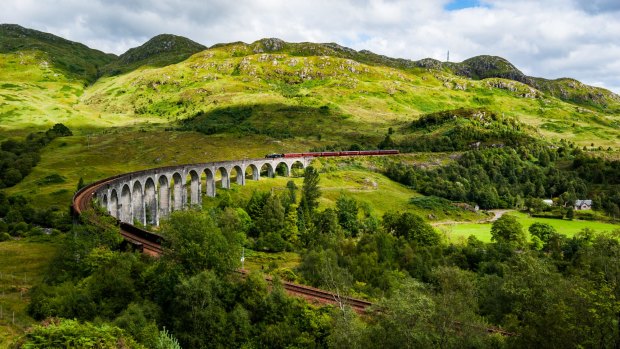
Credit: iStock
The West Highland Line (about $77 round-trip; journey takes five hours), which connects Glasgow with Mallaig in the Western Highlands, is memorable in two ways: for the views, from bleak Rannoch Moor to the elegant arches of Glenfinnan Viaduct, and for the people on board. It's a sociable ride, partly because conditions are cramped and partly because the locals love a chat. On my last trip, the conductor sat down for a 10-minute talk with some regular customers, and a fellow passenger recommended the best station to get off for a smoke. (I don't smoke, but it's the thought that counts.)
RailEurope.com.au is a good resource for buying tickets on all but the Tren de Sóller, where tickets must be bought on the day. For the best in-depth information on rail travel in Europe, visit the regularly updated, comprehensive website seat61.com
The Washington Post
Sign up for the Traveller Deals newsletter
Get exclusive travel deals delivered straight to your inbox. Sign up now.